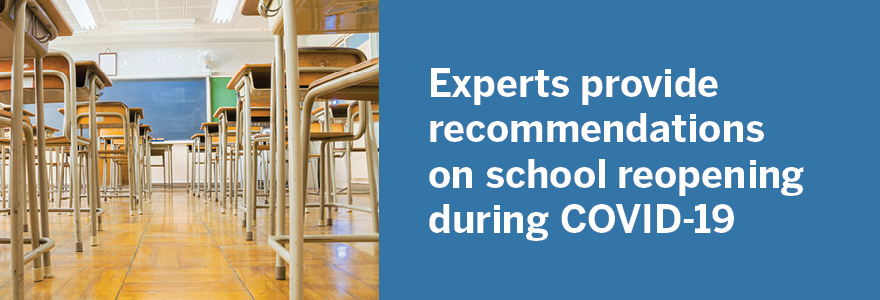
Experts provide recommendations on school reopening during COVID-19

A Western Education researcher and two colleagues are urging the Ontario government to adopt an equity-sensitive localized approach when reopening schools to ensure safety and the best learning opportunities for students.
Professor Prachi Srivastava, Faculty of Education, Yona Nestel, Senior Education Policy and Advocacy Advisor, Plan International, and Professor Karen Mundy, OISE, University of Toronto submitted six recommendations to the Ontario government.
The recommendations are in response to Ontario’s call for consultation on its plan to reopen elementary and secondary schools in the province. Drafted by Srivastava, they are based on a policy brief she is leading with co-authors from UNESCO-IIEP, UNICEF, and INEE for the global T20 Task Force on (COVID-19) Multidisciplinary Approaches to Complex Problems, which will feed into the 2020 G20 Summit.
International best practice shows the least volatile school reopening is in places with comprehensive health measures, keeping in mind the risks children face with long-term school closures. In Ontario, adopting a localized approach to school reopening that integrates community health data with data from schools in different catchment areas is important, said Srivastava.
The government should create a multi-stakeholder task force with education and health experts, and teacher, principal, board, and family and student representatives. This task force could rapidly analyze and disseminate education and health data to guide decisions. Data should focus on vulnerable and at-risk students in each school community.
The first response to the pandemic highlighted the need to support teachers, facilitators, and parents and caregivers to optimally use technologies for learning. This can help minimize disparities due to the digital divide associated with household wealth, social background, and location, which may otherwise combine with learning inequities to widen gaps.
“We’re fortunate in Ontario, and Canada generally, to have enjoyed relative stability for so long. But, this also means that we’re much less prepared for crises and long-term planning in education and other sectors. We have deep inequities – they’re highlighted now”, she said.
A potential future shutdown due to a second wave of COVID-19 create challenges for policymakers. Srivastava said having a concrete medium- and long-term strategy for interrupted opening in 2020-21 with a contingency plan for 2021-22 is a crisis-sensitive approach that will minimize future disruptions.
There should also be a comprehensive remote and distance learning plan beyond a virtual standalone platform to ensure education continues during school closures or during intermittent reopening. Online learning is not appropriate for all learners and subjects. Srivastava said schools should be treated as closed systems in the first phases of reopening. In Ontario, there was a call for education workers to be voluntarily redeployed to high-risk settings, such as long-term care homes. Viral load and exposure could increase transmission risk. Any staff members who volunteered should be quarantined before resuming regular duties and there shouldn’t be any staff exchanges between schools. All teachers and education personnel should be tested before returning, with ongoing COVID-19 testing and mental health supports.
Physical distancing measures will be important once schools reopen. This means planning for potential additional space for teachers and staff. Transportation services and education facilities should be reserved for single schools, said Srivastava.
She added economic security of teachers, administrators, and education workers must be protected which requires continued pay.
The province has announced three scenarios for reopening schools in September. They include: a return to full in-school learning; students continue online learning; a hybrid system of in-school learning and online learning.
School closures in Ontario have affected over two million elementary and secondary school students. Ontario public schools have been closed since March 12.

